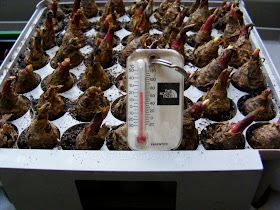Arracacha (Arracacia xanthorrhiza)... may require some introduction. It's a high-yielding starchy root-crop popular in southern Brazil, and parts of the Andes. A member of the Umbelliferae family, and sometimes called the Peruvian Parsnip, it forms sizable crowns with several good-sized edible roots growing below, and propogation shoots above.
All sounds good so far, but it's another crop that has failed to make an impact outside its home territory, probably because of the tricky combination of frost tenderness, and a required growing season of up to 14 months.
Reports are divided on whether it is day-length sensitive.
So... these are arracacha propagules - unrooted buds cut from the plant's crown. This is a named variety, 'Governador Amaral', recently developed in Brazil to have a short growing season — short enough perhaps to crop in a temperate climate such as the UK.
Just like the black Oca which I received recently, these cuttings are seasonally desyncronised, having just been whisked from Brazilian spring to English autumn. I have gleaned enough information to know that they would probably just rot if I tried to induce dormancy using low temperatures, so I'm going to have to try to get them rooted, then nurse them through the coming winter.
Here they are installed in a cozy propagator.
There are bound to be some casualties but if most of them root, I'll have some little plug plants to spare for my friends.
UPDATE 9/11/10
After a couple of weeks, almost all of them have burst into vigorous life, above ground at least. Checking the cut surface of a couple reveals a few short roots starting to reach down into the compost.
They have been spending the nights (and colder days) indoors, in the propagator under a window, but whenever the sun shines and the greenhouse warms up a bit, I'm moving them out to catch what daylight is available. I've even washed the greenhouse glass especially for them!
UPDATE 22/11/10
 Almost all have rooted well, and made nice little plug plants. I used a very sandy open compost to minimise the risk of rot, and the roots have raced down through it.
Almost all have rooted well, and made nice little plug plants. I used a very sandy open compost to minimise the risk of rot, and the roots have raced down through it.
Had I used a normal plug tray with such a crumbly compost, it would have been almost impossible to remove the plugs intact, but the process was, as always, trouble-free using a self-ejecting Agralan plug tray.
I'm potting on promptly to avoid a congested root ball, just in case it results in humorously distorted comedy vegetables at harvest time. Peruvian folk-lore would apparently suggest that this can be a problem; the recommended precaution for growers there is to avoid sleeping with crossed legs during the planting season.
Mission accomplished with regard to rooting. Now I need to slow them down till spring comes, so I'll leave them in an unheated greenhouse from now on, only bringing them indoors on really cold nights.
All sounds good so far, but it's another crop that has failed to make an impact outside its home territory, probably because of the tricky combination of frost tenderness, and a required growing season of up to 14 months.
Reports are divided on whether it is day-length sensitive.
So... these are arracacha propagules - unrooted buds cut from the plant's crown. This is a named variety, 'Governador Amaral', recently developed in Brazil to have a short growing season — short enough perhaps to crop in a temperate climate such as the UK.
Just like the black Oca which I received recently, these cuttings are seasonally desyncronised, having just been whisked from Brazilian spring to English autumn. I have gleaned enough information to know that they would probably just rot if I tried to induce dormancy using low temperatures, so I'm going to have to try to get them rooted, then nurse them through the coming winter.
Here they are installed in a cozy propagator.
There are bound to be some casualties but if most of them root, I'll have some little plug plants to spare for my friends.
UPDATE 9/11/10
After a couple of weeks, almost all of them have burst into vigorous life, above ground at least. Checking the cut surface of a couple reveals a few short roots starting to reach down into the compost.
They have been spending the nights (and colder days) indoors, in the propagator under a window, but whenever the sun shines and the greenhouse warms up a bit, I'm moving them out to catch what daylight is available. I've even washed the greenhouse glass especially for them!
UPDATE 22/11/10
 Almost all have rooted well, and made nice little plug plants. I used a very sandy open compost to minimise the risk of rot, and the roots have raced down through it.
Almost all have rooted well, and made nice little plug plants. I used a very sandy open compost to minimise the risk of rot, and the roots have raced down through it.Had I used a normal plug tray with such a crumbly compost, it would have been almost impossible to remove the plugs intact, but the process was, as always, trouble-free using a self-ejecting Agralan plug tray.
I'm potting on promptly to avoid a congested root ball, just in case it results in humorously distorted comedy vegetables at harvest time. Peruvian folk-lore would apparently suggest that this can be a problem; the recommended precaution for growers there is to avoid sleeping with crossed legs during the planting season.
Mission accomplished with regard to rooting. Now I need to slow them down till spring comes, so I'll leave them in an unheated greenhouse from now on, only bringing them indoors on really cold nights.











